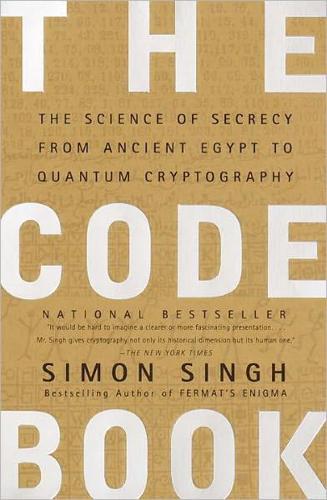
The Code Book: The Science of Secrecy From Ancient Egypt to Quantum Cryptography
by
Simon Singh
Published 1 Jan 1999
The really important question is whether quantum cryptography will arrive in time to save us from the threat of quantum computers, or whether there will be a privacy gap, a period between the development of quantum computers and the advent of quantum cryptography. So far, quantum cryptography is the more advanced technology. The Swiss experiment with optic fibers demonstrates that it would be feasible to build a system that permits secure communication between financial institutions within a single city. Indeed, it is currently possible to build a quantum cryptography link between the White House and the Pentagon. Perhaps there already is one. Quantum cryptography would mark the end of the battle between codemakers and codebreakers, and the codemakers emerge victorious. Quantum cryptography is an unbreakable system of encryption.
…
So far the Los Alamos group has succeeded in transmitting a quantum key through air over a distance of 1 km. Security experts are now wondering how long it will be before quantum cryptography becomes a practical technology. At the moment there is no advantage in having quantum cryptography, because the RSA cipher already gives us access to effectively unbreakable encryption. However, if quantum computers were to become a reality, then RSA and all other modern ciphers would be useless, and quantum cryptography would become a necessity. So the race is on. The really important question is whether quantum cryptography will arrive in time to save us from the threat of quantum computers, or whether there will be a privacy gap, a period between the development of quantum computers and the advent of quantum cryptography.
…
With hindsight, we can see that the cryptanalysts would inevitably figure out a way of breaking each cipher, or developing technology that would break it for them. However, the claim that quantum cryptography is secure is qualitatively different from all previous claims. Quantum cryptography is not just effectively unbreakable, it is absolutely unbreakable. Quantum theory, the most successful theory in the history of physics, means that it is impossible for Eve to intercept accurately the onetime pad key established between Alice and Bob. Eve cannot even attempt to intercept the onetime pad key without Alice and Bob being warned of her eavesdropping. Indeed, if a message protected by quantum cryptography were ever to be deciphered, it would mean that quantum theory is flawed, which would have devastating implications for physicists; they would be forced to reconsider their understanding of how the universe operates at the most fundamental level.
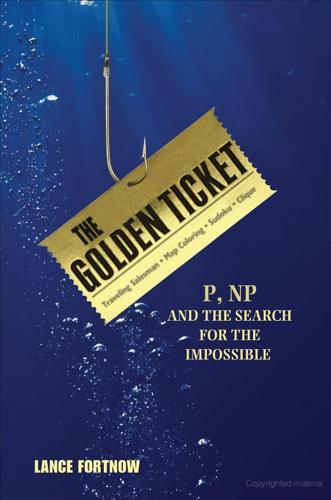
The Golden Ticket: P, NP, and the Search for the Impossible
by
Lance Fortnow
Published 30 Mar 2013
Unlike quantum computing, the basic Bennett-Brassard protocol does not require quantum entanglement, and also unlike quantum computing, there are working implementations of medium-scale quantum cryptography. Researchers at Los Alamos have successfully sent messages over ninety-two miles through fiber optic cables. Others have sent messages between two of the Canary Islands through the air, a distance of nearly ninety miles. One day in the near future we may be able to use quantum techniques to send unbreakable codes via satellite. So why don’t we use quantum cryptography for all secrecy needs? Quantum cryptography is still in the experimental stage, quite expensive, not much bandwidth, and prone to error.
…
The drive would be created by some trusted organization (the U.S. government?) with some method of providing the same pad securely to Facebook and other companies as well. P = NP makes most things much easier, but it makes cryptography a bit more painful. Facebook could also use quantum mechanics to both create and transmit a pad to Alice. We’ll talk more about quantum cryptography in the next chapter, but that approach will likely be too expensive to use on a large scale. Zero-Knowledge Sudoku Bob was spending his lunch hour struggling to solve a Sudoku puzzle from to the day’s newspaper. Bob exclaims in agony, “There must be a mistake in the paper, for this Sudoku puzzle cannot have a solution.”
…
In the decades that followed, computer scientists and physicists, often working together, showed in theory that quantum computers can solve certain problems, such as factoring numbers, much faster. Whether we can actually build large or even medium-scale working quantum computers and determine exactly what these computers can or cannot do still remain significant challenges. In this chapter we explore the power of quantum computing, as well as the related concepts of quantum cryptography and teleportation. The Quantum DVR Tom is a Bostonian and, of course, a huge Red Sox fan. The New York Yankees played in Boston earlier in the day but Tom had to work, and he purposely avoided reading anything about the game. When he got home he ordered in some pizza, fired up the DVR, and started watching the game hours after it had ended.

Erwin Schrodinger and the Quantum Revolution
by
John Gribbin
Published 1 Mar 2012
Together with William Wooters he proved that “a single photon cannot be cloned,” and used that phrase as the title for a paper published in Nature in October 1982 which began: “Note that if photons could be cloned, a plausible argument could be made for the possibility of faster-than-light communication.” Although it ruled out FTL signalling, it was the “no cloning theorem,” also discovered independently by the Dutch physicist Dennis Dieks, that opened the way to the practical use of quantum entanglement to create uncrackable codes—quantum cryptography. There are several approaches to the problem of quantum cryptography, but they all depend on code systems that use a “key” of random numbers. The description here is adapted from my book Schrödinger’s Kittens, since I could not see any way to improve on it. The kind of code I want to describe is familiar from spy stories.
…
Life itself Quantum chemistry The green pamphlet Schrödinger’s variation on the theme The double helix Chapter Thirteen: Back to Vienna Farewell to Dublin Home is the hero Declining years The triumph of entropy Chapter Fourteen: Schrödinger’s Scientific Legacy Hidden reality and a mathematician’s mistake The Bell test and the Aspect experiment Quantum cryptography and the “no cloning” theorem Quantum teleportation and classical information The quantum computer and the Multiverse Quantum physics and reality Postscript Sources and Further Reading Index Copyright © 2013 by Mary and John Gribbin. All rights reserved Cover Design: Tom Poland Cover Image: Professor Erwin Schrödinger © Bettmann/CORBIS Published by John Wiley & Sons, Inc., Hoboken, New Jersey First published in Great Britain in 2012 by Bantam Press an imprint of Transworld Publishers No part of this publication may be reproduced, stored in a retrieval system, or transmitted in any form or by any means, electronic, mechanical, photocopying, recording, scanning, or otherwise, except as permitted under Section 107 or 108 of the 1976 United States Copyright Act, without either the prior written permission of the Publisher, or authorization through payment of the appropriate per-copy fee to the Copyright Clearance Center, 222 Rosewood Drive, Danvers, MA 01923, (978) 750-8400, fax (978) 646-8600, or on the web at www.copyright.com.
…
But a few maverick physicists made a series of wrong-headed but sophisticated attempts to prove that entanglement offers a way to send messages faster than light. They were ultimately proved wrong, but research partly stimulated by their quest has led quantum physics into the almost equally exotic realms of cryptography and teleportation. Quantum cryptography and the “no cloning” theorem One of the people who tried to devise a way to use entanglement to send messages faster than light was Nick Herbert, an American physicist who had completed a PhD at Stanford University in 1967, but had been unable to get an academic post and had worked in a variety of jobs while pursuing his interest in quantum physics in his spare time, together with a group of like-minded thinkers based in Berkeley, California.
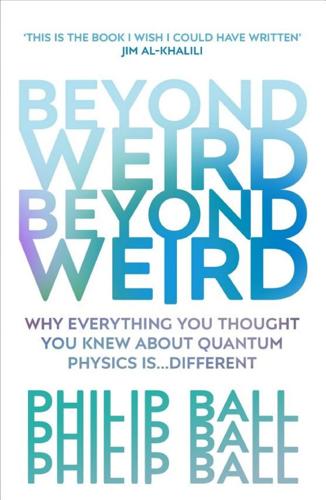
Beyond Weird
by
Philip Ball
Published 22 Mar 2018
Dominic Mayers of the University of Montreal showed in 1997 that for quantum cryptography this unconditionally secure bit commitment is impossible. That doesn’t undermine quantum cryptography, which can still be made secure for all practical purposes. But it exposes some of the limits of what is possible. Well, so far so cryptic. What can be so fundamental about a desideratum for sending secure information? But as we saw earlier, the very existence of quantum information technologies such as quantum computing and quantum cryptography stems from deep features of quantum mechanics. It’s not so much that these features lend themselves to applications in information processing (although that’s true), but that quantum mechanics is increasingly – as Bub says – about information.
…
Inspired by a much earlier suggestion of physicist Stephen Wiesner of Columbia University, Charles Bennett and Gilles Brassard pointed out in the early 1980s that quantum correlations between entangled states can be exploited to send information encoded in qubits that is immune to eavesdropping. The signal could never be intercepted and read without the tampering being detected. This was the start of the technology known as quantum cryptography. The idea goes like this. Alice encodes her message in two entangled qubits – 1s and 0s represented by, say, the polarization states of pairs of photons. One photon from each entangled pair is then sent to Bob, who measures their states and so decodes the message. There are several methods (protocols) for making this process tamper-proof, but in general they exploit the fact that if an eavesdropper (Eve) intercepts any of these photons, with an unknown polarization state, she can’t copy it because she doesn’t know exactly how Alice prepared it and so is snookered by quantum no-cloning.
…
The upshot is that, once Bob has discarded the one in four results he measured wrongly, he and Alice then find there is still not a perfect match in their ‘checking’ subset. This tells them that the transmission was intercepted. So it’s not that the optical signal can’t be intercepted; it can be. But Eve’s snooping can never be hidden from Alice and Bob. Quantum cryptography, says Brassard, ‘offers an unbreakable method for code-makers42 to win the battle once and for all against any possible attack available to codebreakers’. Bennett, Brassard and their students achieved a crude experimental demonstration of their protocol in 1989: adequate to show that the idea could be made to work but nowhere near good enough to be practically useful.

Applied Cryptography: Protocols, Algorithms, and Source Code in C
by
Bruce Schneier
Published 10 Nov 1993
Smolin, “Experimental Quantum Cryptography,” Advances in Cryptology—EUROCRYPT ’90 Proceedings, Springer–Verlag, 1991, pp. 253–265. 122. C.H. Bennett, F. Bessette, G. Brassard, L. Salvail, and J. Smolin, “Experimental Quantum Cryptography,” Journal of Cryptology, v. 5, n. 1, 1992, pp. 3–28. 123. C.H. Bennett and G. Brassard, “Quantum Cryptography: Public Key Distribution and Coin Tossing,” Proceedings of the IEEE International Conference on Computers, Systems, and Signal Processing, Banjalore, India, Dec 1984, pp. 175–179. 124. C.H. Bennett and G. Brassard, “An Update on Quantum Cryptography,” Advances in Cryptology: Proceedings of CRYPTO 84, Springer–Verlag, 1985, pp. 475–480. 125.
…
Charles Bennett, Gilles Brassard, Claude Crépeau, and others have expanded on this idea, describing quantum key distribution, quantum coin flipping, quantum bit commitment, quantum oblivious transfer, and quantum secure multiparty computation. Their work is described in [128,129,123,124,125,133,126,394,134,392,396]. The best overview of quantum cryptography can be found in [131]; [1651] is another good nontechnical overview. A complete bibliography of quantum cryptography is [237]. This would still be on the lunatic fringe of cryptography, but Bennett and Brassard actually went and built a working model of the thing [127,121,122]. Now we have experimental quantum cryptography. So sit back, get yourself something to drink, and relax. I’m going to explain what this is all about. According to quantum mechanics, particles don’t actually exist in any single place.
…
Brassard, “Quantum Public Key Distribution Reinvented,” SIGACT News, v. 18, n. 4, 1987, pp. 51–53. 127. C.H. Bennett and G. Brassard, “The Dawn of a New Era for Quantum Cryptography: The Experimental Prototype is Working!” SIGACT News, v. 20, n. 4, Fall 1989, pp. 78–82. 128. C.H. Bennett, G. Brassard, and S. Breidbart, Quantum Cryptography II: How to Re–Use a One–Time Pad Safely Even if P=NP, unpublished manuscript, Nov 1982. 129. C.H. Bennett, G. Brassard, S. Breidbart, and S. Weisner, “Quantum Cryptography, or Unforgeable Subway Tokens,” Advances in Cryptology: Proceedings of Crypto 82, Plenum Press, 1983, pp. 267–275. 130. C.H.
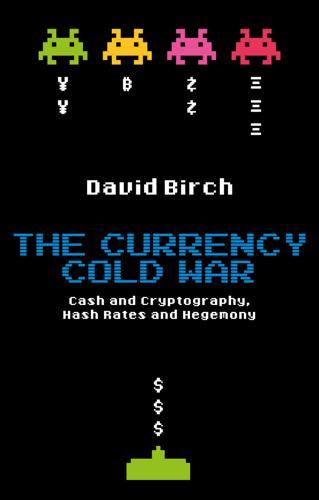
The Currency Cold War: Cash and Cryptography, Hash Rates and Hegemony
by
David G. W. Birch
Published 14 Apr 2020
As an International Monetary Fund (IMF) paper on the subject puts it (see Adrian and Mancini-Griffoli 2019), digital money systems ‘could for instance allow users to determine the goods that e-money could purchase – a useful feature for remittances or philanthropic donations’. That is only the tip of the iceberg, to my mind. An aside: post-quantum cryptography Much of the discussion about meta-technology here rests on the use of asymmetric cryptography (which uses public and private keys), which is at the heart of the practical implementation of e-money. Before I am deluged with letters from sophisticated and educated readers pointing out that the advent of quantum computing may well render widely deployed asymmetric cryptography null and void … I know.
…
Countermeasures Broadly speaking, there are two very different approaches to protecting against the threat posed by quantum computation. One is quantum key distribution, or QKD. This exploits the quantum properties of physical systems, so it requires specialized hardware. The other is post-quantum cryptography, or PQC, which, as with existing forms of asymmetric cryptography, exploits the intractability of certain mathematical problems, so it can be implemented in hardware or software. The goal of PQC (also called quantum-resistant cryptography, or QRC) is to develop cryptographic systems that are secure against both quantum and classical computers, and that can interoperate with existing communications protocols and networks.
…
Glossary ACU: alternative currency unit AI: artificial intelligence AML: Anti-Money Laundering AMLDV: Anti-Money Laundering Directive API: application programming interface BIS: Bank for International Settlements BRI: Belt and Road Initiative (China) BSA: Bank Secrecy Act (United States) CBDC: central bank digital currency CDD: customer due diligence CDP: collateralized debt position CFA: Franc of the Financial Community of Africa CFSI: Centre for the Study of Financial Innovation CHIPS: Clearing House Interbank Payment System CPS: Crime Pays System CTF: counter-terrorist financing DCA: digital currency area DCEP: Digital Currency/Electronic Payment DeFi: decentralized finance ECB: European Central Bank ECU: European Currency Unit ELMI: Electronic Money Institution ESL: enterprise shared ledger FinCEN: Financial Crimes Enforcement Network FINMA: Financial Market Supervisory Authority ICO: initial coin offering IMF: International Monetary Fund IMFS: International Monetary and Financial System JPMC: JPMorgan Chase SHC: synthetic hegemonic currency HMRC: Her Majesty’s Revenue and Customs KYC: Know Your Customer KYZ: Known-bY-Zuck NFC: near-field communication NCSC: National Cyber Security Centre NIST: National Institute of Standards and Technology OFAC: Office of Foreign Assets Control PBoC: People’s Bank of China PEPSI: Pan-European Payment System Initiative PIN: personal identification number Pseudonym: a persistent alias to an identity PQC: post-quantum cryptography SDR: special drawing right SEC: Securities and Exchange Commission SGA (Saga): a partially collateralized stablecoin SHC: synthetic hegemonic currency Sibos: The annual SWIFT banking conference SIM: subscriber identification module, the chip inside a digital mobile phone that links the device to a user SMS: short message service (the GSM text message service) SWIFT: Society for Worldwide Interbank Financial Telecommunications USSD: Unstructured Supplementary Service Data Bibliography Adrian, T., and T.
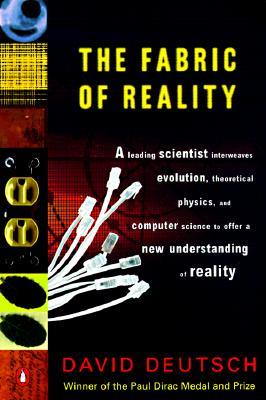
The Fabric of Reality
by
David Deutsch
Published 31 Mar 2012
But there is an additional class of new tasks open to quantum computers that no classical computer could perform at all. By a strange coincidence, one of the first of these tasks to be discovered also concerns public-key cryptography. This time it is not a matter of breaking an existing system, but of {217} implementing a new, absolutely secure system of quantum cryptography. In 1989, at IBM Research, Yorktown Heights, New York, in the office of the theoretician Charles Bennett, the first working quantum computer was built. It was a special-purpose quantum computer consisting of a pair of quantum cryptographic devices designed by Bennett and pilles Brassard of the University of Montreal.
…
At worst, persistent eavesdropper might prevent any communication froi taking place at all (though of course that is more easily achievr just by cutting the telephone line). But as for reading a message, {218} only the intended recipient can do that, and the guarantee of that is provided by the laws of physics. Because quantum cryptography depends on manipulating individual photons, it suffers from a major limitation. Each photon that is successfully received, carrying one bit of the message, must somehow have been transmitted intact from the transmitter to the receiver. But every method of transmission involves losses, and if these are too heavy the message will never arrive.
…
The best existing quantum-cryptographic systems use fibre-optic cables and have a range of about ten kilometres. This would suffice to provide, say, the financial district of a city with absolutely secure internal communications. Marketable systems may not be far away, but to solve the problem of public-key cryptography in general - say, for global communication - further advances in quantum cryptography are required. Experimental and theoretical research in the field of quantum computation is accelerating world-wide. Ever more promising new technologies for realizing quantum computers are being proposed, and new types of quantum computation with various advantages over classical computation are continually being discovered and analysed.
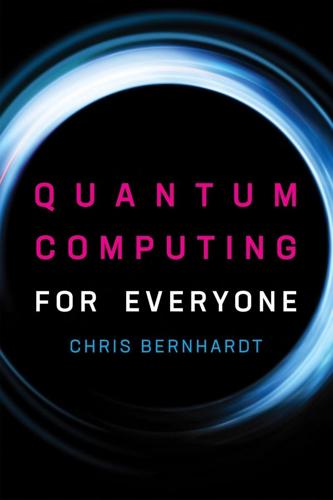
Quantum Computing for Everyone
by
Chris Bernhardt
Published 19 Mar 2019
The mathematical model of spin or, equivalently, that of polarization is given using linear algebra. This enables us to give the definition of a qubit and to describe exactly what happens when we measure it. Several examples of measuring qubits in different directions are given. The chapter ends with an introduction to quantum cryptography, describing the BB84 protocol. Chapter 4. This chapter describes what it means for two qubits to be entangled. Entanglement is difficult to describe in words, but it is easy to describe mathematically. The new mathematical idea is the tensor product. This is the simplest way of combining mathematical models of individual qubits to give one model that describes a collection of qubits.
…
Over the years other methods of encryption have been developed, but Shor’s algorithm also works on many of these. It has become clear that we need to develop new cryptographic methods—and these new methods should be able to withstand not just classical attacks but also attacks by quantum computers. Post-quantum cryptography is now an extremely active area, with new methods of encryption being developed. Of course, there is no reason why these have to use quantum computing. We just need the encrypted message to be able to withstand being broken by a quantum computer. But quantum ideas do give us ways of constructing secure codes.
…
See Complexity classes, EQP Exponential time, 143 Fan-out, 100 Feynman, Richard, 89, 115, 182 Flip about the mean, 179 Flip-flop, 103 Fredkin, Edward, 89, 111, 115 Freedman, Stuart, 82 Function balanced, 146 constant, 146 Functional completeness, 94–96 Garbage bit, 109 Gate AND, 98 controlled not (CNOT), 67, 105 Fredkin, 109 Hadamard, 122 NAND, 99 NOT, 98 OR, 99 Pauli, 121 quantum, 117, 120 reversible, 102 switch, 111 Toffoli, 107 universal, 101, 108, 110, 123 XOR, 102 Gerlach, Walther, 1 Google, 184 Gravity, 75–76 Grover, Lov, 176 Half-adder, 102–103 Hidden variables, 11, 71, 77–78 IBM, 182, 184 ID Quantique, 176 Interference, 52–53, 174 Ion-trap, 183 Josephson junction, 183 Ket, 19 Kronecker product, 149–152 Landauer limit, 105 Linear algebra toolbox, 35 Linearly independent, 165 Linear superposition, 50 Local realism, 71, 75–76 Logical equivalence, 93 Many-worlds view, 85 Matrix, 30 Hadamard, 159–160 identity, 32 Kronecker product, 149–152 main diagonal, 32 multiplication, 31, 32 not commutative, 32 orthogonal, 34 square, 32 transpose, 31 unitary, 34 Micius, 176 Millennium Prize, 144 NMR machine, 185 No cloning theorem, 124–126, 134, 138 Non-commutative operation, 32, 58 NVision Imaging Technologies, 185 Oracle, 145 Ordered basis, 29 Orthonormal basis, 25 Parallelogram law, 22 Parallel universes, 187 Parity check, 137–139 Pauli, Wolfgang, 121 Pauli transformations, 121 Peirce, Charles Sanders, 97 Petzold, Charles, 101 Photosynthesis, 182 Podolsky, Boris, 76 Polarization, 11–15 Polarized filters, 12–15 Polynomial time, 142–144 Post-quantum cryptography, 175 Probability, 37–38 Probability amplitude, 29, 39, 52 Pseudorandom numbers, 15 P versus NP, 144 Pythagorean theorem, 20 Quadratic speedup, 180 Quantized spin, 15 Quantum annealing, 185–186 Quantum bit, 1, 49–50 Quantum bit-flip correction, 137–140 Quantum clock, 6, 14, 68–69, 78 Quantum Fourier transform, 174 Quantum key distribution (QKD), 53, 86, 175–176 Quantum parallelism, 141, 168–169 Quantum speedup, 141 Quantum supremacy, 184, 186–188 Quantum teleportation, 132–135, 176 Quantum tunneling, 186 Qubit.

The Simulation Hypothesis
by
Rizwan Virk
Published 31 Mar 2019
As mentioned earlier, even though it was the result of a paper that Einstein coauthored with Rosen and Podolsky, Einstein himself derided the idea as “spooky action at a distance.” Since then, there has been confirmation that quantum entanglement exists, and it has even been used in the new field of quantum cryptography. Quantum cryptography relies on the strange property that if the quantum field is collapsed (by a particle or qubit being read or observed), then the other entangled particle (or qubit) will also be affected. Thus, it’s possible to know that someone has “read” the secret message. Recent experiments have shown that there are different ways for particles to become entangled.
…
Quantum entanglement seems to have the capacity for instantaneous communication across light years—which means that information would go from one part of our world to another faster than the speed of light. While physicists admit that quantum entanglement exists and is being used in applications like quantum cryptography, there is still plenty of debate about whether two entangled particles actually constitutes sending information from place A to B faster than the speed of light. No one knows exactly how or why quantum entanglement works. We’ll explore this idea and quantum computing in more detail in Chapter 11, Skeptics and Believers: Evidence of Computation, but once again the simulation hypothesis provides us with a model from the world of video games that may be relevant in explaining the previously unexplainable.
…
“simulated reality,” 75 physical world, creation of, 219–221 physics, new, 126–27 physics, old (classical), 124–26 physics engines, 16–17, 36–37, 123, 162, 176–78, 235, 283–84 physics engines vs. rendering engines, 51 “The Physics of Everything Else” (Vallée, TED talk, 2011), 240–41 picture element (pixel), 163 pixelated reality, 161 pixels 3D pixels and particles, 164–65 and 3D rendering engines, 59 characteristics of, 255 created by rendering engine, 51 definition of, 10 games rendered using, 2D to 3D, 42–44 information rendered as, 53 and particles, 162–64 physics engines vs. rendering engine, 51 and quanta, 167–69 rendered pixels, 135 value of, 162–64, 181, 262 and video game languages, 33 and virtual space (pixelated world), 181–82 pixels, experiments for evidence, 255–266 Planck, Max, 167–68, 290 Planck constant, 168, 267 Planck length, 168–69, 175, 181–82 Planck time, 181–82 Planetfall, 29 Plato, 201, 270–71 Play Labs, 6 player characters (PCs), 82, 280–81 player game state, 30 PMR (Physical Matter Reality), 157, 173–74 PNG, 163–64 Podolsky, Boris, 261 Pole Position, 34, 35f Pong, 24–25, 32, 32f possible futures, 12 posthuman civilization, 111–13 Princeton’s Advanced Engineering Research Lab (PEAR), 76 probability wave for a particle, 128f procedural generation, 47 procedurally generated world, 51 “Programming a Computer for Playing Chess” (Shannon, 1950), 85 Project Blue Book, 232 purely deterministic model, 125 Q QI (quantum indeterminancy), 11, 124 QI, philosophical questions raised by, 140–41 Qiyamah, Day of, 221–23 quanta, 10, 126–27, 161, 166–67, 181–82 quanta, of space, 167–69 quantized space and time, 173–76, 288 quantized time, 171–74 quantum computers, 257–260, 267, 273–74 quantum cryptography, 261 quantum entanglement, 179–182, 259–260 quantum entanglement and simulation, 261–63 quantum error correction, 259–260, 263 quantum foam, 168 quantum indeterminacy (QI), 11, 124, 134–35, 139–140, 253, 255, 257, 267, 282–83 quantum leap, 10, 127 quantum mechanics, 133, 168, 254–55, 259 quantum physics many worlds interpretation, 148–150 as new physics, 126–27 physical reality as quantized, 281–82 and physical world, 122–23 quanta in, 166–67 rendering engines based on QI, 283–84 and subjective reality, 10–13 quantum probability wave, 10–11, 130, 253 quantum probability wave, collapse of, 129–130 quantum superposition, 132–34 qubits (quantum bits), 258 quests, 285–86 quests and achievements, 210–11 quests and storylines, 41 R Raiders of the Lost Ark, 38 random number generators (RNGs), 76 raster image, 163–64 Ready Player One, 56–57, 61 “real object” definition, 68–69 reality nature of, 6 world views and religion, 5 real-time motion controls, 36 real-world rendering, 67 rebirth, 201 Reid, Harry, 232 reincarnation, 285–86 reincarnation, theoretical model, 205–8, 206f religion, mysticism and simulation hypothesis, 13–16 remote viewing, 243–44 rendered pixels, 135 rendered world, 42 rendering engine, 3D, 59 rendering engine rules, 138 rendering engine vs. physical engine, 51 rendering engines 2D to 3D, 58–59 and 3D world rendering, 66–67, 123 based on quantum indeterminacy, 282–83 for real world, 3D printers as, 69–71 and Simulation Point, 63–64 speed of, 66–67 rendering engines, speed of, 66 rendering engines vs. physical engines, 51 The Republic (Plato), 5, 270 resource argument, 250–52 retrocausality, 146 retrocausation, 160 Ricard, Matthieu, 207 Ringel, Zohar, 251–52 RNGs (random number generators), 76 role-playing games (RPGs), 38 role-playing games (RPGs), graphical, 39–42 room-scale VR, 55–56 Rosen, Nathan, 178, 261 RPGs (role-playing games), 38 RPGs (role-playing games), graphical, 39–42 Rucker, Rudy, 251–52 Rumi, 183 Rutherford, Ernest, 125, 167–68 Rutherford-Bohr planetary model, 125 S Samsara, 201 Sauvageau, Joe, 254–55 Savage, Martin J., 255 Saved by the Light (Brinkley, 1994), 229–230 Schrödinger, Erwin, 125, 132–34 Schrödinger’s Cat, 132–34, 140, 149, 259 science, goal of, 6 Science Advances, 251–52 scroll of deeds, 222–23 Second Life, 4, 45–46, 50, 56, 71, 177, 180, 191, 209–10, 213 Sedol, Lee, 87 Sega Genesis, 38 The Self-Aware Universe (Goswami), 133 self-contained world (video games), 2–3 SETI (Search for Extraterrestrial Intelligence), 236 seventh yoga, 197–99 Shannon, Claude, 23, 85–86, 104 Siddhartha Gautama, 203 simple programs, 266 The Sims, 4 simulated artificial intelligence (SAI), 281 simulated consciousness, 17–18 simulated world, 3 Simulation Argument, 5, 24–26, 110–11, 112f simulation game, 3–4 simulation hypothesis, 16 AI, gods and angels, 226–28 and conscious based arguments, 267 and dreams, 196–97 experiments for, 254–55 to explain the unexplainable, 20–21 fundamental question of, 4–5 the Great Simulation, 19–20 implications of Plato’s allegory of the cave, 270–71 OBEs, remote viewing, telepathy and other “unexplained” phenomena, 241–44 and parallel universes, 159–160 and quantum indeterminacy (QI), 139–140 and quantum physics, 10–13 and quests, 213–14 in religion and mysticism, 13–16 and resource based arguments, 267 and science fiction, 6–10 and simulations, computation and chaos, 18–19 storage of consciousness, 117 video game model based on karma, 211–13 virtual reality, artificial intelligence, and simulated consciousness, 16–18 as world explanation, 118–19 simulation hypothesis, arguments/experiment categories evidence of conditional rendering, 248–49 evidence of consciousness, 248 evidence of negation, 248 evidence of pixels or computation, 249 Simulation point, 20, 25–26 simulation point, stages current stage, 49–52 definition of, 26–27 reaching stage 9, 92–94 stage 0: text adventures and game worlds (1970s to mid-1980s), 27–31 stage 1: graphic arcade and console games (1970s-1980s), 32–38 stage 2: graphical adventure / RPG games (1980s- 1990s), 38–42 stage 3: 3D rendered MMORPGs and virtual worlds (1990s-Today), 42–48 stage 4: immersion using virtual reality, 54–62 stage 5: photorealistic augmented and mixed reality (AR, MR), 62–66 stage 6: real-world rendering: light-field display and 3D printing, 66–72 stage 7: mind interfaces, 72–77 stage 8: implanted memories, 77–80 stage 9: artificial intelligence and NPCs, 82–84 stage 10: downloadable consciousness and digital immortality, 100 stage 11: reaching the simulation point, 107–8 simulation point, defining, 107–8t simulation point, stage 9 requirements ability to create further AI, 94 learning over time, 93–94 Natural Language Processing (NLP), 92 natural language response, AI/NPCs, 92 physical interactions, 94 spatial awareness, 94 voice output, AI/NPCs, 93 voice recognition, AI/NPCs, 93 simulations, 153–55 simultaneity between events, 12 single-player text adventures, 27–31 singularity, 82, 100–101 The Singularity is Near (Kurzweil, 2005), 101 Siri, 88 Six Yogas of Naropa (Tsongkhapa), 192, 198 skeptics: resource argument, 250–52 Skyfall, 70 SNLP (statistical NLP), 89–90 social media and AGI, 98 Sony PlayStation VR headset, 60 Sophia (robot), 91, 91f souls, 285–86 Space Invaders, 34, 35f, 36, 82, 87, 208, 273 space time, 181–82 space time, instant travel, simulation overview, 176 quantum entanglement, 176, 180–81 teleportation, 176–78 wormholes, 176, 178–180 SpaceWar!

Dawn of the New Everything: Encounters With Reality and Virtual Reality
by
Jaron Lanier
Published 21 Nov 2017
At the top of a chain of primitive gods would be a more profound idea of God, which is just as accessible without thinking about all the intermediate gods. Ultimate reality is always right in front of you, so why even pay the middlemen any mind? Or: I predicted that the success of quantum cryptography would suggest we’re not being observed, that we’re not in VR in any consequential way. Quantum cryptography uses the most fundamental properties of nature to absolutely prove that a message hasn’t been read before. The act of observation changes a quantum system no matter who observes, man or god. Quantum cryptography turned out to work! So, if you believe that argument, there’s now less reason to worry that we might be in VR. Another line of argument is usually associated with the more recent work of philosophers like Nick Bostrom, but it was around back at the Little Hunan.16 Roughly: If there is a multitude of alien civilizations, a bunch of them would develop high-quality VR, so there would be many VR systems running, but only one real universe.
…
See also cephalopods Octopus Butler Robot Oculus Oculus Rift oil exploration olfaction Olympics Ono, Yoko open-source movement operating system, first commercial optical bench optical sensors optic nerve optimizing compiler options for action, biasing Oracle Organ Mountains organomania origami oscillators oscilloscope pain management Palestine, Charlemagne Palo Alto Paracomp paralyzed bodies paranoia Parrish, Maxfield Pascal’s Wager patents Patricof, Alan pattern recognition Patterson, Penny Pauline, Mark Pausch, Randy Pavlov, Ivan PDP-11 computer Peace Prize of the German Book Trade Pentland, Sandy perception pereiopods perfection peripheral vision Perlin, Ken Perry, Commodore personal computers personal data, commerce and personal thinking Pfizer Phantom device phantom limbs phenotropic programming Philco photography photons physical reality physical therapy physics Piaget, Jean piano Piestrup, Ann McCormick pinnae Pixar Pixel Planes pixels Plants as Inventors (book) Platonic images Platonic sizzle Platonic Solids Pleiades Pluto Pocket Big Brain pointing and selecting on screen Polhemus Porras Luraschi, Javier postsymbolic communication poverty Power Glove power relationships Prime Directive printers Prisoner’s Dilemma privacy productivity software Programmers at Work (book) programming. See also code culture; hackers programming languages. See also specific languages projected augmented reality proprioception protocols Prozac psychedelic drugs psychedelic magazines PTSD Punch and Judy avatars punch cards Pynchon, Thomas quantum computing quantum cryptography quantum field theory racism radio Radio Shack radio waves Ramachandran, V. S. Rand, Ayn Rathinavel, Kishore Rational thought RB2 (Reality Built for Two) Reagan, Ronald Réalité virtuelle reality. See physical reality reality distortion field Reality Engines Reality Masher Reality on Wheels real time 3-D computers real-time shadows Reddit redundancy refraction reincarnation religious tolerance REM sleep Rent-a-Mom Republican Party retina retinal displays Rheingold, Howard Rhemann, Christoph Rhythm Gimbal rights, abstract vs. economic Robinette, Warren robotic arm robotic broomstick robotic hand robotic Loch Ness-type creature robotic mimic of mimic octopus robots robust system rock climbing Rockwell, Norman Rocky’s Boots Roddenberry, Gene Roko’s Basilisk Rosedale, Philip Rosen, Joe Rosenberg, Scott Rosenthal, Sally Roswell, New Mexico rounds, startups and Royal portable typewriter Rumi Russian intelligence sales tax Salisbury, Ken Sandin, Dan San Francisco San Francisco Bay Bridge Santa Cruz Sante, Luc Satava, Rick Sault Ste.
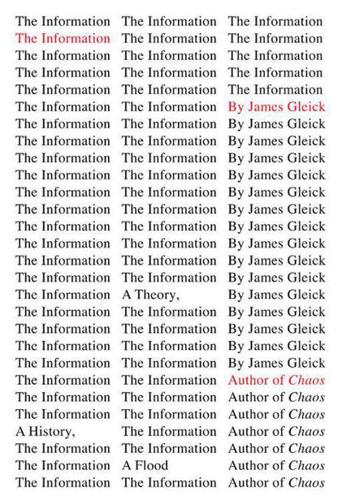
The Information: A History, a Theory, a Flood
by
James Gleick
Published 1 Mar 2011
Bennett and his research assistant John Smolin jury-rigged it in 1988 and 1989 with a little help from the machine shop: an aluminum box spray-painted dull black on the inside and further sealed with rubber stoppers and black velvet.♦ With a helium-neon laser for alignment and high-voltage cells to polarize the photons, they sent the first message ever to be encoded by quantum cryptography. It was a demonstration of an information-processing task that could be effectively accomplished only via a quantum system. Quantum error correction, quantum teleportation, and quantum computers followed shortly behind. The quantum message passed between Alice and Bob, a ubiquitous mythical pair.
…
♦ STRAIGHT AND NARROW OLD IBM TYPE: Charles Bennett, quoted by George Johnson in “Rolf Landauer, Pioneer in Computer Theory, Dies at 72,” The New York Times, 30 April 1999. ♦ “YOU MIGHT SAY THIS IS THE REVENGE”: Interview, Charles Bennett, 27 October 2009. ♦ BENNETT AND HIS RESEARCH ASSISTANT: J. A. Smolin, “The Early Days of Experimental Quantum Cryptography,” IBM Journal of Research and Development 48 (2004): 47–52. ♦ “WE SAY THINGS SUCH AS ‘ALICE SENDS BOB’ ”: Barbara M. Terhal, “Is Entanglement Monogamous?” IBM Journal of Research and Development 48, no. 1 (2004): 71–78. ♦ FOLLOWING AN INTRICATE AND COMPLEX PROTOCOL: A detailed explanation can be found in Simon Singh, The Code Book: The Secret History of Codes and Codebreaking (London: Fourth Estate, 1999); it takes ten pages of exquisite prose, beginning at 339
…
“Notes on Landauer’s Principle, Reversible Computation, and Maxwell’s Demon.” arXiv:physics 0210005 v2 (2003). ———. “Publicity, Privacy, and Permanence of Information.” In Quantum Computing: Back Action 2006, AIP Conference Proceedings 864, edited by Debabrata Goswami. Melville, N.Y.: American Institute of Physics, 2006. Bennett, Charles H., and Gilles Brassard. “Quantum Cryptography: Public Key Distribution and Coin Tossing.” In Proceedings of IEEE International Conference on Computers, Systems and Signal Processing, 175–79. Bangalore, India: 1984. Bennett, Charles H., Gilles Brassard, Claude Crépeau, Richard Jozsa, Asher Peres, and William K. Wootters. “Teleporting an Unknown Quantum State Via Dual Classical and Einstein-Podolsky-Rosen Channels.”

The Mysterious Mr. Nakamoto: A Fifteen-Year Quest to Unmask the Secret Genius Behind Crypto
by
Benjamin Wallace
Published 18 Mar 2025
May, “Libertaria in Cyberspace,” EX, September 1, 1992. GO TO NOTE REFERENCE IN TEXT For more than two thousand years: An excellent overview of the history of cryptography can be found in Simon Singh, The Code Book: The Evolution of Secrecy from Mary, Queen of Scots, to Quantum Cryptography (New York: Doubleday Anchor, 2000). GO TO NOTE REFERENCE IN TEXT a remarkable discovery: Martin E. Hellman, “An Overview of Public Key Cryptography,” IEEE Communications Society Magazine, May 2002. GO TO NOTE REFERENCE IN TEXT “A specter is haunting the modern world”: Tim May, “The Crypto Anarchist Manifesto,” in Peter Ludlow, Crypto Anarchy, Cyberstates, and Pirate Utopias (Cambridge, MA: MIT Press, 2001), 61–63.
…
GO TO NOTE REFERENCE IN TEXT “human stylome”: Hans van Halteren et al., “New Machine Learning Methods Demonstrate the Existence of a Human Stylome,” Journal of Quantitative Linguistics 12, no. 1 (2005): 65–77. GO TO NOTE REFERENCE IN TEXT the Caesar cipher [footnote]: Simon Singh, The Code Book: The Evolution of Secrecy from Mary, Queen of Scots, to Quantum Cryptography (New York: Doubleday Anchor, 2000), 9–11, 17–19. GO TO NOTE REFERENCE IN TEXT The pioneering scholars: Frederick Mosteller and David L. Wallace, Inference and Disputed Authorship: The Federalist (Reading, MA: Addison-Wesley, 1964). GO TO NOTE REFERENCE IN TEXT “bag of words”: Jacob Murel, PhD, and Eda Kavlakoglu, “What is bag of words?
…
GO TO NOTE REFERENCE IN TEXT a ten-mile race in Santa Barbara: Jameson Lopp, “Hal Finney Was Not Satoshi Nakamoto,” Cypherpunk Cogitations (blog), October 21, 2023. GO TO NOTE REFERENCE IN TEXT Occam’s Razor a trio in England: Steven Levy, Crypto: Secrecy and Privacy in the New Code War (New York: Penguin, 2002), 313–30; Simon Singh, The Code Book: The Evolution of Secrecy from Mary, Queen of Scots, to Quantum Cryptography (New York: Doubleday Anchor, 2000), 279–92. GO TO NOTE REFERENCE IN TEXT mentioning COINTELPRO: Mark Mazzetti, “Burglars Who Took on F.B.I. Abandon Shadows,” The New York Times, January 7, 2014. GO TO NOTE REFERENCE IN TEXT Only forty-three years after the burglary: Betty Medsger, The Burglary: The Discovery of J.

Cryptoassets: The Innovative Investor's Guide to Bitcoin and Beyond: The Innovative Investor's Guide to Bitcoin and Beyond
by
Chris Burniske
and
Jack Tatar
Published 19 Oct 2017
We will go deeper into the specifics of the process in the proof-of-work section that follows, but for now here’s the takeaway: cryptography allows the computers building Bitcoin’s blockchain to collaborate in an automated system of mathematical trust. There is no subjectivity as to whether a transaction is confirmed in Bitcoin’s blockchain: it’s just math. For a deep dive on cryptography, we highly recommend The Code Book: The Science of Secrecy from Ancient Egypt to Quantum Cryptography by Simon Singh. Immutable The combination of globally distributed computers that can cryptographically verify transactions and the building of Bitcoin’s blockchain leads to an immutable database, meaning the computers building Bitcoin’s blockchain can only do so in an append only fashion.
…
See also Yuan (China) Bitcoin and, 126–128 exchanges in, 126, 217 Christensen, Clayton, 264–265, 267, 273–274 Classification, 199 of assets, 108 ICO and, 258–261 CME. See Chicago Mercantile Exchange CMOs. See Collateralized mortgage obligations Code, 7, 223 lines of, 197–198 The Code Book: The Science of Secrecy from Ancient Egypt to Quantum Cryptography (Singh), 15 Code Repository Points, 195–197 Coinbase, 111, 114, 201, 221, 292n11 as web wallet, 225 CoinCap, 286 CoinDance, 286 Coindesk.com, 198, 199, 202, 207, 209, 286 CoinMarketCap.com, 286 CoinWarz, 215 COINXBT. See Bitcoin Tracker One Cold storage, 221–222 Collaboration, 111 community and, 56 platforms for, 159 Collateralized mortgage obligations (CMOs), 4–5 Colored coins, 53 Commodities, 80, 172, 276–277 Commodities Futures Trading Commission (CFTC), 107, 112, 224, 276 Communication, 14 Communication Nets, xxiii Community, 57, 62 collaboration and, 56 of computers, 18 developers and, 182 Companies, 28, 63, 118 as incumbents, 264–273 interface services by, 113 OTC by, 216 as peer-to-peer, 13 perspective of, 249–250 risk and, 75 support and, 198–200 technology and, 264–265 value of, 152 venture capitalism for, 248 Competition, 16, 214 Compound annual growth rate (CAGR), 118–119 Compound annual returns, 87, 88, 103–104 Computer scientists, 60 Computers blockchain technology and, 26, 186 community of, 18 as miners, 16 for mining, 212 private keys on, 226 supercomputers as, 59 Consortium, 272–273 Consumable/Transformable (C/T) Assets, 109–110 Content, 174 Corbin, Abel, 164–165 Cornering, 163–166 cryptoassets and, 166–168 Correlation coefficient, 101 Correlation of returns, 74–76 Correlations, 122 assets and, 74 Bitcoin and, 133 cryptoassets and, 101–102 market behavior and, 132–135 Counterparty, 53–54 CPUs.
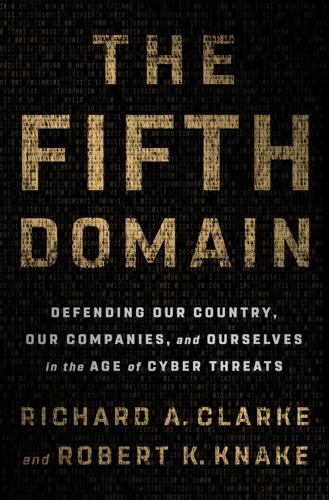
The Fifth Domain: Defending Our Country, Our Companies, and Ourselves in the Age of Cyber Threats
by
Richard A. Clarke
and
Robert K. Knake
Published 15 Jul 2019
The Chinese government has what: Stephen Chen, “China Building World’s Biggest Quantum Research Facility,” South China Morning Post, September 11, 2017, www.scmp.com/news/china/society/article/2110563/china-building-worlds-biggest-quantum-research-facility. quantum-resistant encryption standard: “Post-Quantum Cryptography,” National Institute of Standards and Technology, CSRM.NIST.com, accessed January 4, 2019, csrc.nist.gov/projects/post-quantum-cryptography. Chapter 17: 5G and IoT quarter trillion dollars: Hillol Roy, “Tackling the Cost of a 5G Build,” Accenture, August 3, 2018, www.accenture.com/us-en/insights/strategy/5G-network-build. publicly published 132 questions: “Promoting Unlicensed Use of the 6 Ghz Band,” Notice of Proposed Rulemaking, Federal Communications Commission, October 2, 2018, https://docs.fcc.gov/public/attachments/DOC-354364A1.pdf.
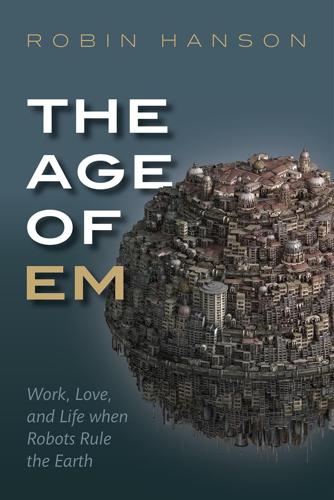
The Age of Em: Work, Love and Life When Robots Rule the Earth
by
Robin Hanson
Published 31 Mar 2016
Strong barriers might separate hardware that runs em minds from hardware that runs most other software, and visible rituals involving the participation of other trusted ems might be required to copy em minds, especially when moving to distant hardware. When ems must move their brains, such as to meet with a fast em who lives far away, they might prefer to use strongly encrypted communication channels. It might help to use quantum cryptography, which takes advantage of the fact that it is physically impossible to copy quantum states. The value of doing so is disputed, however (Stebila et al. 2010). Ems may also discourage mind theft by limiting the resale value of the skills held in any one em’s mind. This might be accomplished by acquiring skills that are tied to small unique organizational contexts, and that are less valuable outside those contexts.
…
If quantum computing became feasible on large scales, then a few kinds of important calculations could be done faster and cheaper, including factoring, certain kinds of search, and simulations of small-scale physical systems (Viamontes et al. 2005). While this allows and perhaps forces a switch to quantum cryptography, it appears to have little impact on most other forecasts in this book. While it is possible to create quantum states that cannot be copied, this is unlikely to typically be a useful way to prevent mind theft; the many practical gains from easy copying seem too large to forego. A variation with substantial implications is where some method is found to usefully merge two em minds that had once split from a common ancestor, with the combined mind requiring not much more space and processing power than did each original mind, yet retaining most of the skills and memories of both originals.
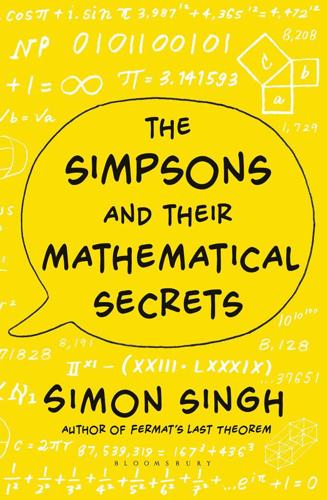
The Simpsons and Their Mathematical Secrets
by
Simon Singh
Published 29 Oct 2013
BY THE SAME AUTHOR Fermat’s Enigma: The Epic Quest to Solve the World’s Greatest Mathematical Problem (US edition) Fermat’s Last Theorem: The Story of a Riddle that Confounded the World’s Greatest Minds for 358 Years (UK edition) The Code Book: The Science of Secrecy from Ancient Egypt to Quantum Cryptography Big Bang: The Origin of the Universe Trick or Treatment: The Undeniable Facts about Alternative Medicine First published in Great Britain 2013 This electronic edition published in 2013 by Bloomsbury Publishing Plc Copyright © 2013 by Simon Singh The moral right of the author has been asserted All rights reserved You may not copy, distribute, transmit, reproduce or otherwise make available this publication (or any part of it) in any form, or by any means (including without limitation electronic, digital, optical, mechanical, photocopying, printing, recording or otherwise), without the prior written permission of the publisher.
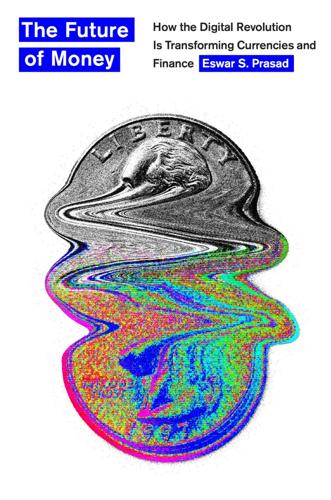
The Future of Money: How the Digital Revolution Is Transforming Currencies and Finance
by
Eswar S. Prasad
Published 27 Sep 2021
The Building Blocks The quoted text is from Satoshi Nakamoto, “Bitcoin Open Source Implementation of P2P Currency,” Satoshi Nakamoto Institute (blog), February 11, 2009, https://satoshi.nakamotoinstitute.org/posts/p2pfoundation/1/. Cryptography For an engaging tour of cryptography, ranging from the ancient past to modern quantum cryptography, see Singh (1999). For a more comprehensive overview, see Kahn (1996). Some historians argue that the Polish code breakers did not receive sufficient credit for their accomplishments. See, for instance, Craig Bowman, “Polish Codebreakers Cracked Enigma in 1932, before Alan Turing,” War History Online, May 30, 2016, https://www.warhistoryonline.com/featured/polish-mathematicians-role-in-cracking-germans-wwii-codesystem.html.
…
New Haven, CT: Yale University Press. Sidrauski, Miguel. 1967. “Inflation and Money Growth.” Journal of Political Economy 75, no. 6: 796–810. Sims, Christopher A. 2013. “Paper Money.” American Economic Review 103, no. 2: 563–584. Singh, Simon. 1999. The Code Book: The Evolution of Secrecy from Mary Queen of Scots to Quantum Cryptography. New York: Doubleday. Soman, Dilip. 2003. “The Effect of Payment Transparency on Consumption: Quasi-experiments from the Field.” Marketing Letters 14, no. 3: 173–183. Sorkin, Andrew Ross. 2010. Too Big to Fail: The Inside Story of How Wall Street and Washington Fought to Save the Financial System—and Themselves.

Whiplash: How to Survive Our Faster Future
by
Joi Ito
and
Jeff Howe
Published 6 Dec 2016
,” Medium, March 17, 2014, https://medium.com/@austinhill/on-your-permanent-record-f5ab81f9f654#.ak8ith7gu. 21 Felix Martin, Money: The Unauthorized Biography (New York: Knopf Doubleday Publishing Group, 2015). 22 Ibid., 43. 23 Ibid., 55–60. 24 Simon Singh, The Code Book: The Science of Secrecy from Ancient Egypt to Quantum Cryptography (New York: Knopf Doubleday Publishing Group, 2011). Kindle Edition, chapter 1: “The Cipher of Mary, Queen of Scots.” 25 Ibid. 26 Pierre Berloquin, Hidden Codes & Grand Designs: Secret Languages from Ancient Times to Modern Day (New York: Sterling Publishing Company, Inc., 2008). 27 Singh, The Code Book. 28 Ibid. 29 Singh, The Code Book, chapter 2: “Le Chiffre Indéchiffrable”; Richard A.

Possible Minds: Twenty-Five Ways of Looking at AI
by
John Brockman
Published 19 Feb 2019
When he initially proposed it, quantum computation seemed practically impossible. But the explosion in the construction of simple quantum computers and quantum communication systems never would have taken place without his work. He has made many other important contributions in areas such as quantum cryptography and the multiverse interpretation of quantum theory. In a philosophic paper (with Artur Ekert), he appealed to the existence of a distinctive quantum theory of computation to argue that our knowledge of mathematics is derived from, and subordinate to, our knowledge of physics (even though mathematical truth is independent of physics).

The Singularity Is Near: When Humans Transcend Biology
by
Ray Kurzweil
Published 14 Jul 2005
Marcikic et al., "Long-Distance Teleportation of Qubits at Telecommunication Wavelengths," Nature 421 (January 2003): 509–13; John Roach, "Physicists Teleport Quantum Bits over Long Distance," National Geographic News, January 29, 2003; Herb Brody, "Quantum Cryptography; in "10 Emerging Technologies That Will Change the World," MIT Technology Review, February 2003; N. Gisin et al., "Quantum Correlations with Moving Observers," Quantum Optics (December 2003): 51; Quantum Cryptography exhibit, ITU Telecom World 2003, Geneva, Switzerland, October 1, 2003; Sora Song, "The Quantum Leaper," Time, March 15, 2004; Mark Buchanan, "Light's Spooky Connections SetNew Distance Record," New Scientist, June 28, 1997. 82.
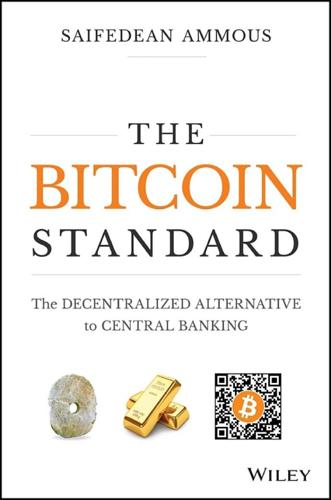
The Bitcoin Standard: The Decentralized Alternative to Central Banking
by
Saifedean Ammous
Published 23 Mar 2018
Forty Centuries of Wage and Price Controls: How Not to Fight Inflation. Ludwig von Mises Institute, 1979. Schumpeter, Joseph A. Capitalism, Socialism and Democracy. Routledge, 2013. Simon, Julian. The Ultimate Resource. Princeton University Press, 1981. Singh, Simon. The Code Book: The Science of Secrecy from Ancient Egypt to Quantum Cryptography. Anchor, 2000. Skousen, Mark. “The Perseverance of Paul Samuelson's Economics.” Journal of Economic Perspectives 11, no. 2 (1997): 137–152. Smith, Vernon. Rationality in Economics. New York: Cambridge University Press. 2008. Steil, Benn. The Battle of Bretton Woods: John Maynard Keynes, Harry Dexter White and the Making of a New World Order.
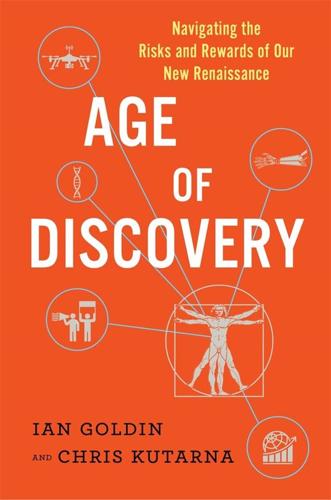
Age of Discovery: Navigating the Risks and Rewards of Our New Renaissance
by
Ian Goldin
and
Chris Kutarna
Published 23 May 2016
Since then, they’ve been steadily boosting the reliability and distance of the quantum jump, with the idea of one day building a quantum Internet. (As of 2015, the distance record is 150 km—a useful theoretical milestone, since that’s also the minimum distance between the ground and orbiting satellites.) In the 2000s, quantum cryptography became real: it is now possible to generate a truly random passcode that is physically impossible to predict, to transmit it some 300 km, and for the recipient to know with absolute certainty whether it was intercepted en route.20 Commercial versions of such systems have already secured bank transfers and the transmission of national election results.

Sunfall
by
Jim Al-Khalili
Published 17 Apr 2019
He leaned forward and grabbed her by the shoulders. For a brief moment she wondered whether he was going to try and shake some sense into her. Instead, he said, ‘But the whole point of quantum key distribution is that you can’t eavesdrop without giving yourself away! I may not be as smart as you, Reenie, but I know enough from my quantum cryptography classes that this is the whole fucking point of the system. Any attempt to break the code disturbs the delicate quantum entangled state and sends an alert to the source, which then immediately switches to a different encryption key. Wasn’t that the subject of last week’s lecture – something about the Ekert 91 protocol?’

The Patient Will See You Now: The Future of Medicine Is in Your Hands
by
Eric Topol
Published 6 Jan 2015
The Federal Trade Commission needs to be charged with proscribing the selling of an individual’s medical data without their unconditional consent.73 If we cannot provide the absolute maximal assurance of privacy and security for each individual’s medical data, or if the government decides to effectively tolerate hacking, medical emancipation will never get started. New technologies to achieve this critical goal, such as quantum cryptography,74a deserve careful consideration. The Food and Drug Administration, while paying lip service to innovation, has done little to alter its regulatory approval processes to catalyze the ways that each individual can assume a greater role in their medical care. That’s why your smartphone isn’t as smart as it could be74b in an ambiguous regulatory landscape.74c It will be a hard and slow slog to new medicine without marked changes in the way innovation is recognized and encouraged, such as by faster reviews, conditional approval, and tight post-market electronic surveillance.
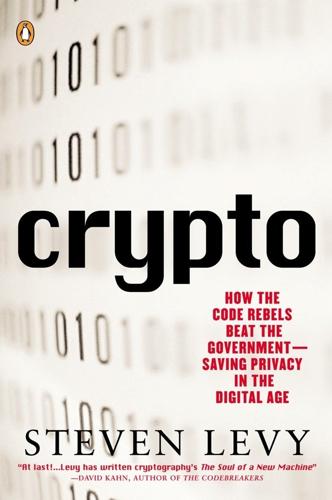
Crypto: How the Code Rebels Beat the Government Saving Privacy in the Digital Age
by
Steven Levy
Published 15 Jan 2002
The Electronic Privacy Papers: Documents on the Battle for Privacy in the Age of Surveillance. New York: Wiley Computer Publishing, 1997. Simmons, Gustavus J., ed. Contemporary Cryptography: The Science of Information Integrity. New York: IEEE Press, 1992. Singh, Simon. The Code Book: The Evolution of Secrecy from Mary Queen of Scots to Quantum Cryptography. New York: Doubleday, 1999. Sterling, Bruce. The Hacker Crackdown. New York: Bantam, 1993. Wallace, Jonathan D., and Mark Mangan. Sex, Laws, and Cyberspace. New York: Holt, 1996. Wrixon, Fred B. Codes and Ciphers. Englewood Cliffs, NJ: Prentice-Hall, 1992. Zim, Herbert T. Codes and Secret Writing.
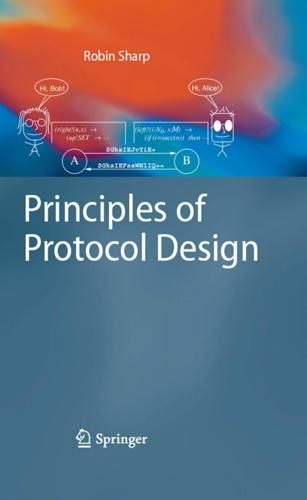
Principles of Protocol Design
by
Robin Sharp
Published 13 Feb 2008
General reviews can also be found in many books on the architecture and design of distributed systems, such as reference [98]. Brassard’s monograph “Modern Cryptology” [18] is a good modern review of cryptographic methods, which discusses not only the well-known DES and RSA methods, but also methods based on newer research, such as keyless cryptography and quantum cryptography. Schneier’s book “Applied Cryptography” [113] gives a comprehensive review of cryptographic methods and a detailed presentation of concrete algorithms. More mathematical aspects of cryptography are dealt with in the “Handbook of Applied Cryptography”, edited by Menezes, van Oorschot and Vanstone [89].
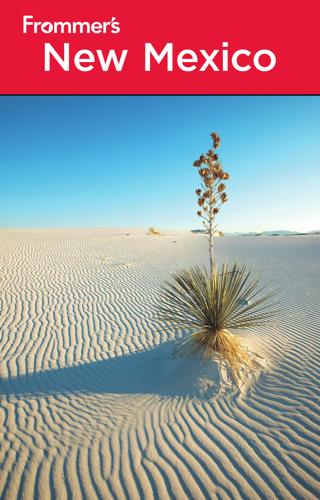
Frommer's New Mexico
by
Lesley S. King
Published 2 Jan 1999
Currently Los Alamos National Laboratory is building a limited number of replacement plutonium pits for use in the enduring U.S. nuclear weapons stockpile. The lab has the only plutonium-processing facility in the United States that is capable of producing those components. An unusual town, Los Alamos has the highest per capita Ph.D. population in the nation—22 percent. If you listen closely you may hear people talk of such complexities as quantum cryptography, trapdoor functions of polynomial integers, reciprocal space and heterogeneous multicores. With researchers convening here from all over the world, the accents range from Russian to French to Japanese and even a Texas twang or two. 7 SANTA FE LOS ALAMOS & BANDELIER NATIONAL MONUMENT Orientation/Useful Information Los Alamos is about 35 miles west of Santa Fe and about 65 miles southwest of Taos.

Engineering Security
by
Peter Gutmann
Another thing you may notice about this book is that there’s no mention of your favourite piece of cool security technology. In fact there’s no mention of lots of cool security technology, because there’s an awful lot of it out there and much of it will never really benefit anyone except the stockholders of the companies peddling it, if that. An example of this is quantum cryptography, a not-entirely-secure, short-range and above all extraordinarily expensive way of achieving what we’ve been doing using Diffie-Hellman key exchange since the mid-1970s. It uses physics, or magic, or something like that so it’s got to be good. There really isn’t room to cover all of these fashion-statement technologies (although I’ve made passing reference to a few in places where I wanted to illustrate something), so if you find that I’ve omitted to mention your pet technology then it’s most probably because I feel that it’s unlikely to have much, if any, effect on the bad guys, and because this book is already long enough as it is.
…
In any case if an attacker is really that keen to get at the data then they can always go for more practical approaches like directly targeting the communicating devices rather than investing in blind signal demodulation equipment. A generalisation of this is the concept of tamper-evident pairing, which uses the same general principles as quantum key distribution from quantum cryptography. This works by exchanging information over a potentially public channel on which it’s possible to detect attempts to interfere with the exchange. If there’s no interference, the exchange was successful. If there’s interference, it wasn’t successful and needs to be repeated. In the worst case it can never complete, but that’s no different from a denial-of-service attack on a more conventional exchange.